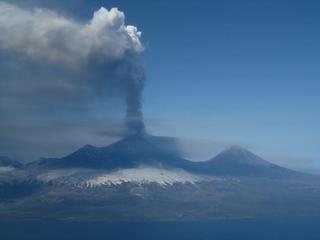Pavlof Eruption Grounds Some PenAir, Grant Flights

Wednesday, June 04 2014
Update, 5 p.m. Wednesday: All PenAir flights to Cold Bay and Unalaska and Grant Aviation flights to Unalaska were canceled today as Pavlof continued to erupt.
PenAir spokeswoman Missy Roberts says at least 200 people were impacted by the airline's cancelations today.
She’s not sure yet if they’ll be able to fly tomorrow. If they can, she says they’ll try to add extra flights for stranded passengers.
And there are still no reports of ashfall in Cold Bay, though winds are blowing ash almost directly west -- but Game McGimsey of the Alaska Volcano Observatory says they did get a report of ash falling on Sand Point.
PenAir told the AVO they had to sweep off their runways and plane windshields before flying there Wednesday morning. McGimsey says it’s surprising for ash to have blown that way, but not impossible.
There haven’t been any volcano-related flight cancelations in Sand Point so far.
Update, 12 p.m. Wednesday: Ash is still blowing from the erupting Pavlof Volcano, prompting airlines in the Alaska Peninsula region to cancel some flights Wednesday morning.
PenAir canceled its morning flights from Anchorage to Cold Bay and Unalaska. And all Grant Aviation flights in and out of Unalaska are on hold right now.
PenAir’s service to Sand Point has not been affected. There’s no word yet on the status of the airline’s afternoon flights.
Staff at PenAir and Grant say a shift in the winds is carrying the volcano’s ash and steam plume to the southwest, in the way of their planes. And bad weather makes it hard to visually track the plume’s location.
That’s been true at the Alaska Volcano Observatory, too -- but geologist Game McGimsey estimates the plume is around 20,000 to 24,000 feet high. Most of that is steam, with ash at the lower levels.
Right now, it’s all being carried toward Cold Bay. But McGimsey says they haven’t had any reports of ash falling on the town. He says Pavlof’s eruption hasn’t been explosive, meaning it generates finer ash that doesn’t settle as quickly. That’s typical for the volcano, which is the most active in the state.
McGimsey says the eruption could last for several days, or much longer. Last year around this time, Pavlof erupted for more than two months.
Related stories:
- Pavlof Volcano Eruption Sends Ash Toward Cold Bay (June 3, 2014)



